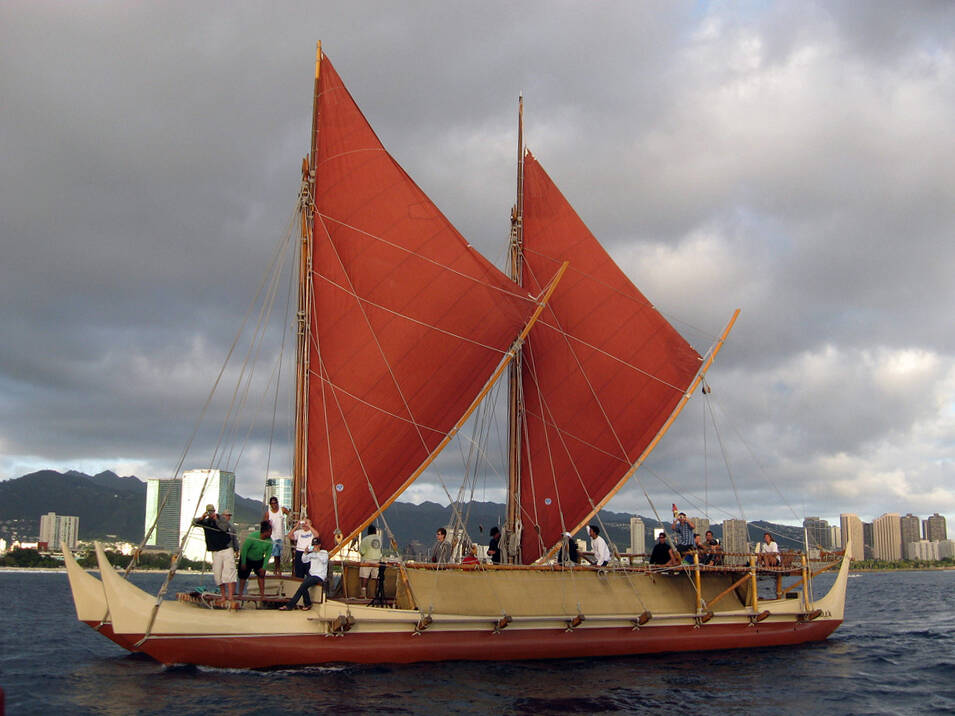(Honolulu, HI) – Hōkūleʻa’s first public port of call after sailing through British Columbia, Canada on the Moananuiākea Voyage will be Seattle, Washington. The legendary voyaging canoe that revived the lost art of Polynesian voyaging and navigation and propelled a cultural renaissance in Hawaiʻi, is slated to arrive at Seattle’s Pier 62 on Saturday, August 26, at 8:00 am. After seeking permission, the crew will be received and welcomed by the Muckleshoot Tribe, a Federally Recognized Indian Tribe composed of descendants of the Duwamish and Upper Puyallup Peoples who inhabited Central Puget Sound for thousands of years before non-Indian settlement.
Following the welcome ceremony, cultural protocols and canoe tours at Pier 62, Hōkūleʻa will be docked at Bell Harbor Marina for three days of public canoe tours. On August 30, Hōkūleʻa will sail to the Foss Waterway Seaport Museum in Tacoma where the canoe will remain until September 1, for public canoe tours. A schedule of community events will be announced soon.
Hōkūleʻa’s Seattle port engagement is being organized and hosted by the Muckleshoot Indian Tribe, Port of Seattle, Waterfront Park Seattle, Bell Harbor Marina, Visit Seattle, and others.
Tacoma planning efforts involve the Pullayup Tribe, the Foss Waterway Seaport Museum, and a host of volunteers including Hawaiian and Pacific Islander performers. Overall coordination for both cities was provided by the Seattle and Tacoma Community of Kānaka, Hawaiʻi-affiliated groups, the outrigger canoe community, and supporters of Hōkūleʻa.
“The Port of Seattle welcomes the crew of the Hokule’a and the message they bring from indigenous voices across the Pacific Ocean – protect our most cherished values and places from disappearing,” said Port of Seattle Commissioner Fred Felleman. “The importance of their message is underscored as we lament the tragic losses from the devastating fire in Lahaina.”
“Seattle and Tacoma are key anchor stops for the Moananuiākea Voyage. It’s a special place and environment with a strong indigenous presence and a large population of Native Hawaiians and Pacific Islanders,” said Nainoa Thompson, CEO of the Polynesian Voyaging Society. “We look forward to engaging with all of these communities as well as the science and ocean institutions that are keeping an eye on the living systems of this changing earth. This voyage is about exploring, discovering, learning and sharing so that we can make better decisions for our future.”
Hōkūleʻa has been sailing south from Southeast Alaska since the Polynesian Voyaging Society (PVS) held its global launch of the four-year circumnavigation of the Pacific in Juneau, Alaska on June 15. The canoe and her crew are currently sailing through British Columbia where they continue to engage with First Nations communities.
The Moananuiākea Voyage, led by PVS, will cover an estimated 43,000 nautical miles around the Pacific, visiting 36 countries and archipelagoes, nearly 100 indigenous territories and more than 300 ports.
The goal of the voyage is to ignite a movement of 10 million “planetary navigators” by developing young leaders and engaging communities around the world to take part in navigating earth towards a healthy, thriving future. The voyage itself is a global educational campaign that will amplify the vital importance of oceans and indigenous knowledge through port engagements, education and storytelling shared via a virtual “Third Canoe” called Waʻa Honua, which translates to “a canoe for the earth” (www.waahonua.com). PVS and its educational partners are creating stories, and lessons for all ages with the goal of inspiring people to care for and make better choices for the earth.
Regional Sail Plan (Subject to change):
- June to September 2023 – Alaska, British Columbia, Seattle, Tacoma
- September to November 2023 – West Coast of the United States
- January to February 2024 – Mexico, Central America, South America
- March 2024 to May 2025 – Exploring the largest country in the world, our country, Polynesia (December 2024 to May 2025 – Aotearoa)
- May to March 2026 – Melanesia, Micronesia (Satawal, Palau)
- March to September 2026 – West Asia-Pacific, ending in Japan
- September to December 2026 – Shipping from Japan to Los Angeles then sailing home to Hawaiʻi
- Spring 2027 – Tahiti
For additional information on PVS and the Moananuiākea Voyage, visit www.hokulea.com or follow @hokuleacrew on Facebook, Twitter, Instagram, and YouTube. Video Overview of Moananuiākea Voyage.
About Hōkūleʻa: A symbol of cultural revival, Hōkūleʻa’s story is being shared on this journey to inspire other indigenous communities. This replica of an ancient Polynesian voyaging canoe was built 49 years ago and revitalized voyaging and navigation traditions throughout the Pacific. The canoe’s twin hulls allow her to handle large ocean swells and recover easily in the troughs of waves, and her triangular canvas sails can harness winds up to 20 knots. Hōkūleʻa first set out on the Pacific Ocean in 1975. Through the revival of the traditional art and science of wayfinding – navigating the sea guided by nature using the ocean swells, stars, and wind – Hōkūleʻa sparked a Hawaiian cultural renaissance and has reawakened the world’s sense of pride and strength as voyagers charting a course for our Island Earth. Hōkūle’a continues to bring people together from all walks of life. She is more than a voyaging canoe — she represents the common desire shared by the people of Hawaii, the Pacific, and the World to protect our most cherished values and places from disappearing.
About Polynesian Voyaging Society: The Polynesian Voyaging Society was founded in 1973 on a legacy of Pacific Ocean exploration, seeking to perpetuate the art and science of traditional Polynesian voyaging and the spirit of exploration through experiential educational programs that inspire students and their communities to respect and care for themselves, one another, and their natural and cultural environments.





